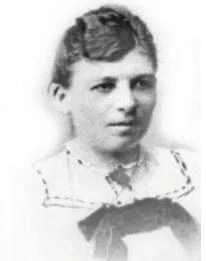A black and white photo of Emma Trosse, a white woman with dark hair tied back. She looks off camera. She wears a white top with a black bow tie.
“Let a man live as a woman among women, put himself into women's clothing, visit their social circles, their intimate meetings, take part in their small joys and their sufferings, their playful games [Spielereien], let him above all experience long talks face to face! If one had the moral courage and strength to not break character, he would experience things of which our most bold fantasies could not dream. We will look into the soul of women as an open book of wonders.”
– Emma Trosse
There is a rich queer linguistic history in Germany. Many of the words still used to talk about queerness originated there with people like Magnus Hirschfeld, a man whose contributions to the modern queer community cannot be overstated. A lesser discussed name is Emma Trosse, and with her, the beginnings of asexuality as an identity can be found. Standing on the legacy of Karl Heinrich Ulrichs and possibly writing some of her work defending queer identities before Hirschfeld, her name deserves more discussion.
Born in the Kingdom of Prussia on January 6, 1863, Emma Trosse was able to access a thorough education early in life, with both of her parents being teachers. She would learn seven languages and was reportedly one of the only and first women allowed to attend psychology lectures at Friedrich Wilhelm University in Berlin in the 1880s and 1890s. Due partially to this, Trosse could access a diversity of experiences in her life. Becoming a poet, writing documents that the government classed as “obscene”, building the first sanatorium in Neuenahr for people suffering from diabetes with her husband, running and working at a boarding school with Hermine Dulsmann whom she was said to be in a romantic relationship with.
She believed that there was still much to be learned about women’s sexuality, writing:
“Let a man live as a woman among women, put himself into women's clothing, visit their social circles, their intimate meetings, take part in their small joys and their sufferings, their playful games [Spielereien], let him above all experience long talks face to face! If one had the moral courage and strength to not break character, he would experience things of which our most bold fantasies could not dream. We will look into the soul of women as an open book of wonders.”
Her most enduring legacy though comes from her medical writing, where she became the first woman known to write a scientific book about homosexuality titled Der Konträrsexualismus in Bezug auf Ehe und Frauenfrage (Homosexuality in relation to marriage and the question of women's rights). Within her writings around queerness, she would use words such as Urning, which comes from Karl Heinrich Ulrichs, and would demand sympathy for “contrary sexuals” writing:
“I will continually exert my full strength to destroy that weak deception and help to open the eyes of those it affects. For only when one has learned to see can one rightly comprehend and judge the poor creatures who are damned without having been understood or heard, or who—if one is being benevolent—are passed by with a sympathetic shrug of the shoulders.
That is an Urning! How may we take further notice of him? With this hard, loveless feeling one renounces once and for all his fellow creature.”
Coming from a great legacy of scientific writers coming to the defense of queerness, she would immortalize herself with the word Sinnlichkeit, which is the origin of the current word asexual. Not only did she note the existence of people whom the community would now recognize as asexual or demisexual, but she would also identify herself among them.
In 1900 she would marry Dr. Georg Alexander Constantin Külz. Because married women in Germany were not allowed to teach, she instead worked with her husband to found a sanatorium for people with diabetes. She used her scientific knowledge to become a clinician and continued writing on medicine with her husband. She continued writing almost until her death in 1946.
The life of Emma Trosse is not one often examined. Her name, though remembered, is not held with the same regard as many others within queer history. Despite the incredible steps she took as an asexual activist and woman in a medical world that often rejected her expertise, her story is not written about nearly as often as her contemporaries. While there are a myriad of reasons for this, one thing is clear, throughout her life, she worked to build thorough solidarity throughout the queer community. She connected gender, sexuality, and writing to the best of her ability to progress the overall queer movement.
REFERENCES AND FURTHER READING
Disclaimer: Some of the sources may contain triggering material
Christiane Leidinger. (2005). Emma (Külz-)Trosse (1863-1949). Lesbengeschichte. https://www.lesbengeschichte.org/Englisch/bio_trosse_e.html
DK. (2023). The LGBTQ + History Book: Big Ideas Simply Explained. Penguin.
Jens Dobler. (n.d.). Emma Trosse, married Külz – Teacher, head, author: An exhibition on the pioneer of homosexual-emancipational journalism. Emma Trosse, Married Külz – Teacher, Head, Author: An Exhibition on the Pioneer of Homosexual-Emancipational Journalism. Retrieved January 24, 2024, from https://www.schwulesmuseum.de/ausstellung/emma-trosse-verheiratete-kuelz-lehrerin-leiterin-autorin-eine-ausstellung-ueber-die-vorreiterin-der-homosexuellen-emanzipatorischen-publizistik/?lang=en
Leck, R. M. (2016). Vita Sexualis: Karl Ulrichs and the Origins of Sexual Science. University of Illinois Press.
Library—UofA Library. (n.d.). Retrieved January 24, 2024, from https://ezpa.library.ualberta.ca/ezpAuthen.cgi?url=ezp.2aHR0cHM6Ly9lZHMucC5lYnNjb2hvc3QuY29tL2Vkcy9kZXRhaWwvZGV0YWlsP3ZpZD0xJnNpZD1iYzA4YzhmNi1kM2U0LTQyOWMtOWEzZC00MzU3MDBjYTFjOTElNDByZWRpcyZiZGF0YT1Kbk5wZEdVOVpXUnpMV3hwZG1VbWMyTnZjR1U5YzJsMFpRJTNkJTNk#AN=alb.8119931&db=cat03710a

